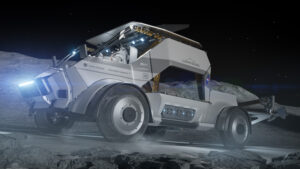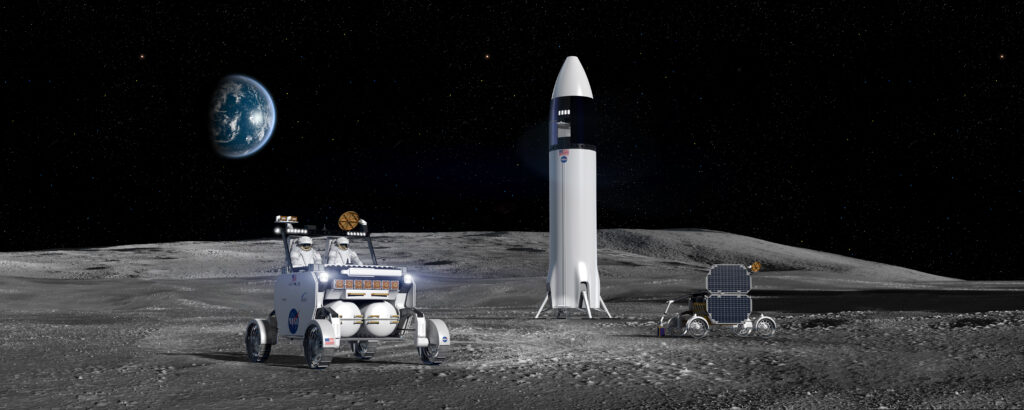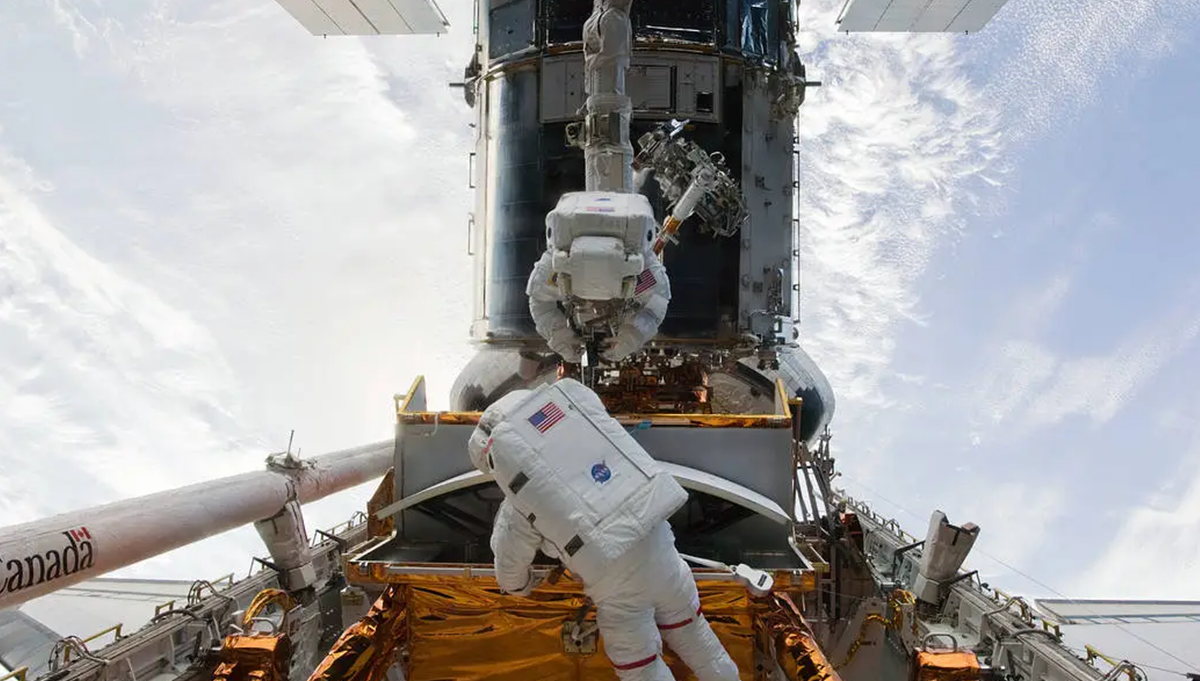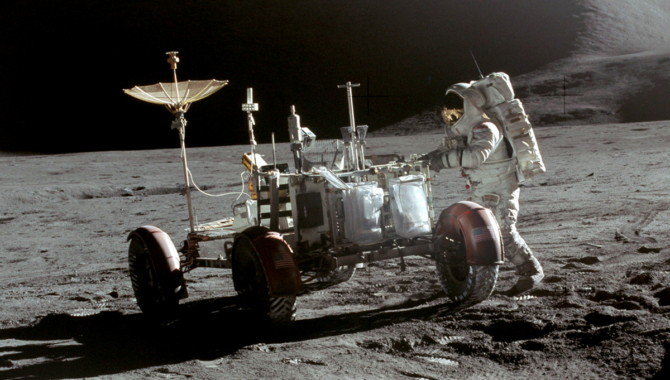
Apollo 15 Commander David Scott took this image of Lunar Module Pilot Jim Irwin beside the Lunar Roving Vehicle at the end of the mission’s first EVA. The LRV dramatically expanded the ground astronauts could cover during the final three Apollo missions. Photo Credit: NASA
New lunar vehicle for astronauts will also be capable for robotic exploration at the Moon’s South Pole.
Apollo 15 was the fourth human lunar landing, but when astronauts David R. Scott and James B. Irwin descended to the surface of the Moon in the summer of 1971, it represented an important first. Folded within the base of their Lunar Module was a new, specialized vehicle that looked like a high-tech version of a dune buggy but was more aptly described as a manned spacecraft on wheels.
The Lunar Roving Vehicle was an engineering marvel, designed with remarkable redundancy to operate in the abrasive dust and high heat of the lunar day. A motor at each of the four wheels was strong enough to drive the entire vehicle if the other three failed. Both the front wheels and rear wheels were capable of steering.
Astronauts were no longer confined to distances they could hop across the harsh lunar surface in bulky spacesuits. Scott and Irwin covered 17.5 miles, much more than the previous three lunar missions combined. The astronauts of Apollo 15, 16, and 17 returned to Earth with 632 pounds of lunar samples, which are still being studied today.
NASA has even higher goals for the Artemis-generation Lunar Terrain Vehicle (LTV), which the agency will develop by contracting with industry partners. Astronauts will be able to drive the LTV across the harsh terrain of the Moon’s South Pole to sites of scientific interest. And when there are no astronauts on the lunar surface, NASA will be able to operate the LTV remotely.
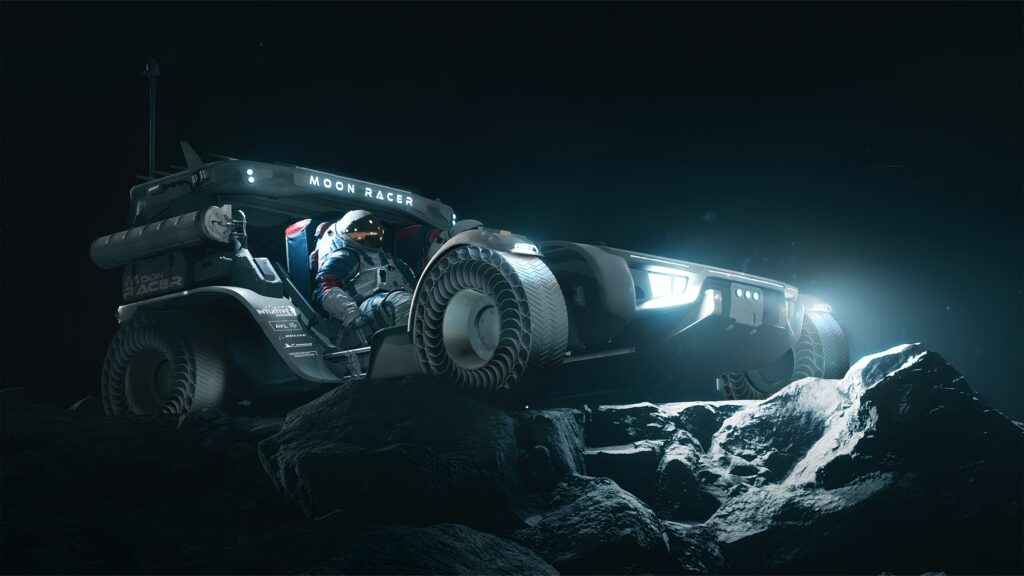
Artist’s rendering of Intuitive Machines’ Moon RACER lunar terrain vehicle. Image Credit: Intuitive Machines
“We are combining the best of human and robotic exploration,” said Jacob Bleacher, Chief Exploration Scientist, speaking at a NASA press conference. “Crews will use the LTV to explore. They’ll transport scientific equipment, and they’ll collect samples from the lunar surface, from much farther than they could if they were on foot alone. Between the Artemis missions, when our astronauts are not on the Moon, NASA can use the LTV’s remote operation capabilities to continue exploring.”
“We’ll be able to operate the LTV to meet our crew when they arrive on the surface. That means they’ll be ready to go right away to focus on the exploration that benefits the most from having our astronauts there,” Bleacher said. “Then, after the crew leave, the LTV can continue remote operations for additional exploration, prospecting, science, similar to robotic explorers that we have on Mars right now. This can help us identify priorities for our next crewed missions.”
Earlier this month, NASA announced the selection of three companies to begin a 12-month feasibility phase. The companies will work with NASA teams on their designs, building on data the agency has gathered about the Moon in recent decades. The teams will also consider how their LTV designs can be incorporated into the overall architecture NASA is developing to establish a long-term human presence at the Moon.
The companies are:
- Intuitive Machines, working with a team that includes AVL, Boeing, Michelin, and Northrop Grumman.
- Lunar Outpost, working with a team that includes Lockheed Martin, General Motors, MDA Space, and Goodyear.
- Astrolab, working with a team that includes Axiom Space, Odyssey Space Research, and Venturi.
“We tried very hard in this requirement set to not be too dictative,” said Lara Kearney, manager of NASA’s Extravehicular Activity and Human Surface Mobility Program. “We wanted to give just high-level functional requirements, but with an understanding of what the environment is.”
The Moon’s South Pole is marked by wide, deep craters, the floors of which are in permanent shadow, with temperatures as cold as -414 degrees Fahrenheit. The Sun remains close to the horizon there, casting long shadows over the landscape. At the same time, some peaks in the region are in bright sunlight for more than 200 Earth days a year.
“There are some areas in the polar regions that are extremely harsh. There are permanent shadows where we never see sunlight. We often hear talking about surviving the day. Well, a lunar day in the South Pole can be hundreds of Earth days, depending on where you go. That’s the knowledge that we have learned over the last several decades that really enables us to take advantage of the lunar environment to our benefit,” Bleacher said.
“Instead of viewing the Moon as a harsh environment that’s difficult, I would suggest that maybe we view the advantages we can use to our benefit at the polar region,” Bleacher said. “Again, that lighting, it can be hard if you go into the dark places, but it can be easier if we are taking advantage of places with longer access to light.”
“We have asked the companies to meet a ten-year operating life. We did not define how they needed to do that.”
How the LRV designs balance time in the frigid shadows, where the water ice and other scientific targets are found, and time in areas of extreme heat and bright sun will be one of the key engineering challenges. NASA did not define how these LRV systems had to be powered.
“We have asked the companies to meet a ten-year operating life. We did not define how they needed to do that. They could, for instance, come in and say, ‘I’m going to deliver one rover, it’s going to last 10 years.’ Or, ‘I’m going to deliver 10 rovers that only last one year.’ We wanted to be able to give them, again, these high-level requirements and then they could innovate on how they wanted to solve those problems,” Kearney said.
The feasibility phase will culminate with a preliminary design review. After that, NASA anticipates a competitive request for proposal for a demonstration task order, which will enable the company selected to finish the development of their LTV, deliver it to the surface of the Moon, and demonstrate it in advance of the arrival of the Artemis V crew. NASA will buy the use of the LTV, which will remain the property of the company that developed it and could be available commercially to other agencies and companies.
To learn more about NASA’s plans for the next generation of Lunar Terrain Vehicle, click here.






